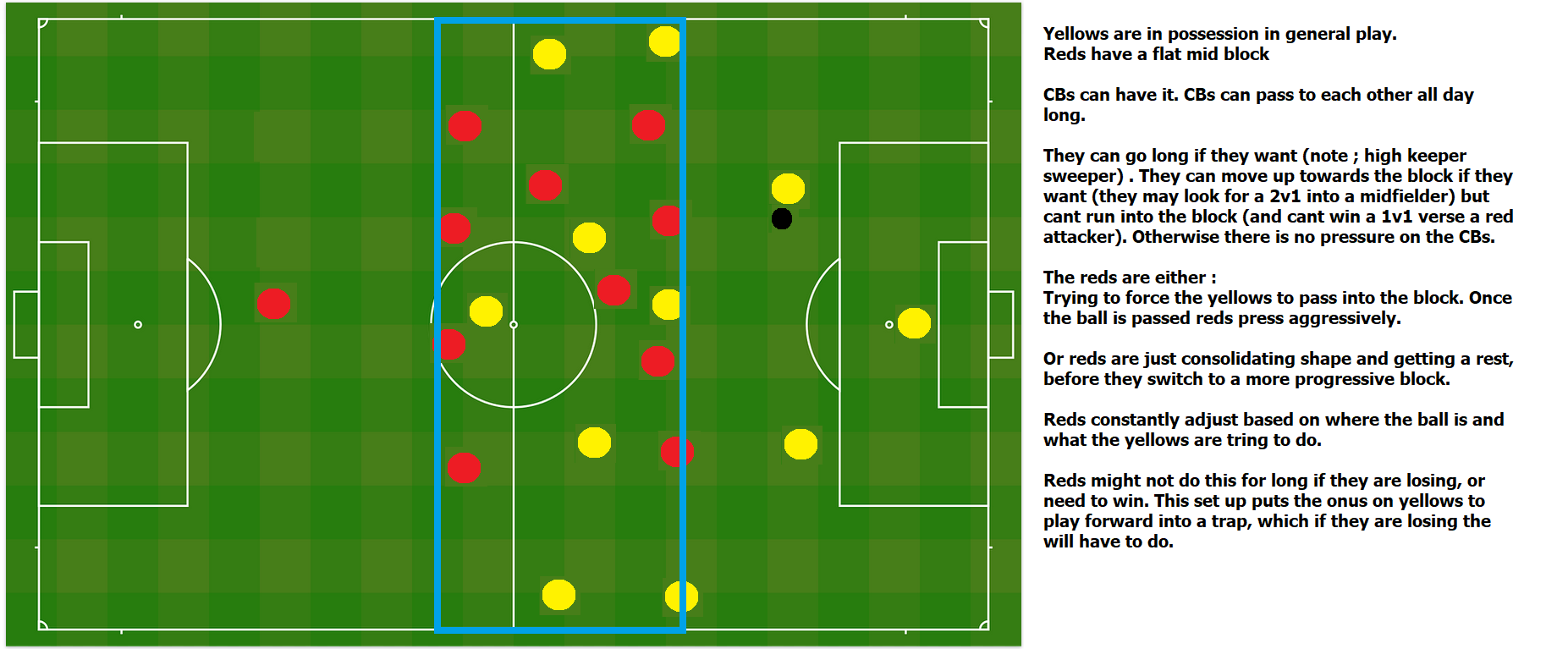What is a block?
Firstly, understand what a Block is :
A block simply describes the moments when a team sets up as a very tight and compact unit across the pitch.
Depending on the type of block, the higher players in a block, may not actually be interested in winning the ball. All they want to is force the opposition to in a predictable way.
When to form a Block :
A team needs to form a block when the opposition are in possession (BPO) and
- You want to slow the opposition play down and then set up a trap.
- Or a 'trap or a full squeeze' has failed.
So a 'Trap : Drop : Block' (looked at later) means the 'trap' has failed and it is now really important to recover as quickly as possible , by getting behind the ball as quickly as possible, and by forming a barrier in front ot the the ball (forming a new bloke (lowerthan the previous block), and making it almost impossible for the opposition to play forward, and if they do, then they are playing into a congested space, and to your advantage.
There are a few different types of Block :
On this page we start by looking at the a :
Flat Mid [or High] Block
Flat Mid Block
The 'Mid' in this term, means the block is step roughly centered near the half way line. (It can be higher, with the high line maybe up to the edge of the center circle.
A higher block would be come a 'high block or a high press' and lower position might become a 'low block'.
Regardless of the type of block, the block needs to be compact, so that there is minimal space between the horizintal lines, otherwise it may become easy for the opposition to play through the lines.
The 'flat' in this term means their is no forward press. The wingers , 9 and 10 do not put pressure on the CBs and are happy for the CBs to go long (boot the ball forward), to play into the midfield spaces or run with the ball towards the midfield space / towards the block. [This would work if the Opposition CBs are poor on the ball, and so letting them have all this freedom to stuff up is ok. But note if the opposition CBs can play then they might cause problems if they are allowed to move forward on the ball, and look for a 2v1 opportunity in the midfield space or hit long forward balls].

A high flat block
A high flat block is very similar except it sits on the edge of the box (rather than in middle of the pitch), and gives the GK and CBs the option to bang the ball over the top. The trap is on the pass into the block zone, preferably into the 6 space. If the opposition break the block, then drop and block until all players are back behind the ball again.
Some individual defending might be needed to be done well, to slow the attack down. [Remember DDDDBW].
When to press (the trap) in a Flat block :
Whenever the ball enters the 'Midfield space' there is an aggressive press from the nearest players. This is the trap. We want the CBs to play into midfield, and when they do, we should be in a position to put immediate pressure on this pass and the first touch of the receiver.
Effort Required :
This type of block doesn't required a huge amount of effort from any one player. It is a good way to conserve energy if this is required or to buy a little bit of time before switching to a more aggressive block.
If the trap in any block fails :
As always if the trap fails then : Drop and Block (except now the block will most likely be a low block).
Match the block to the requirements of the moment.
If the CBs are good, and we do not want to give them an opportunity to 'play' forward, then a 9-10 block (mid) would be a better option. The 9-10 block is covered on the next page. If one CB is poor then a flat mid block may better when they have the ball, and if the other CB can play, then a 9-10 block may be a better option on this center half.